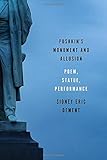Pushkin’s Monument and Allusion : Poem, Statue, Performance / Sidney Eric Dement.
Material type: TextPublisher: Toronto : University of Toronto Press, [2019]Copyright date: ©2019Description: 1 online resource (280 p.)Content type:
TextPublisher: Toronto : University of Toronto Press, [2019]Copyright date: ©2019Description: 1 online resource (280 p.)Content type: - 9781487532239
- 891.713 23
- online - DeGruyter
| Item type | Current library | Call number | URL | Status | Notes | Barcode | |
|---|---|---|---|---|---|---|---|
 eBook
eBook
|
Biblioteca "Angelicum" Pont. Univ. S.Tommaso d'Aquino Nuvola online | online - DeGruyter (Browse shelf(Opens below)) | Online access | Not for loan (Accesso limitato) | Accesso per gli utenti autorizzati / Access for authorized users | (dgr)9781487532239 |
Browsing Biblioteca "Angelicum" Pont. Univ. S.Tommaso d'Aquino shelves, Shelving location: Nuvola online Close shelf browser (Hides shelf browser)

|

|

|

|

|

|

|
||
| online - DeGruyter Early Modern Asceticism : Literature, Religion, and Austerity in the English Renaissance / | online - DeGruyter The Dramaturgy of the Spectator : Italian Theatre and the Public Sphere, 1600–1800 / | online - DeGruyter The Court and Its Critics : Anti-Court Sentiments in Early Modern Italy / | online - DeGruyter Pushkin’s Monument and Allusion : Poem, Statue, Performance / | online - DeGruyter Fides in Flavian Literature / | online - DeGruyter And in Our Hearts Take Up Thy Rest : The Trinitarian Pneumatology of Frederick Crowe, SJ / | online - DeGruyter Heavenly Fatherland : German Missionary Culture and Globalization in the Age of Empire / |
Frontmatter -- Contents -- Figures -- Acknowledgments -- Introduction: Dimensions of the Pushkin Monument -- Chapter One. Pushkin’s Poem: Monument and Allusion (1811–1836) -- Chapter Two. Opekushin’s Pushkin Monument: Statue and Performance (1836–1880) -- Chapter Three. Bulgakov’s Master and Margarita: Crisis of the Future Poet (1880–1937) -- Chapter Four. Toporov’s Petersburg Text: Rejecting the Statue (1937–2003) -- Chapter Five. Tolstaia’s Slynx: Disfiguring the Monument (1986–2000) -- Conclusion: Allusion and the Naive Reader -- Appendix -- Notes -- Bibliography -- Index
restricted access online access with authorization star
http://purl.org/coar/access_right/c_16ec
In August 1836, Alexander Pushkin wrote a poem now popularly known simply as "Monument." In the decades following his death in January 1837, the poem "Monument" was transformed into a statue in central Moscow: the Pushkin Monument. At its dedication in 1880, the interaction between the verbal text and the visual monument established a creative dynamic that subsequent generations of artists and thinkers amplified through the use of allusion, simultaneously inviting their readers and spectators into a shared cultural history and enriching the meaning of their original creations. The history of the Pushkin Monument reveals how allusive practice becomes more complex over time. As the population of literate Russians grew throughout the twentieth century, both writers and readers negotiated increasingly complex allusions not only to Pushkin’s poem, but to its statuesque form in Moscow and the many performances that took place around it. Because of this, the story of Pushkin’s Monument is also the story of cultural memory and the aesthetic problems that accompany a cultural history that grows ever longer as it moves into the future.
Mode of access: Internet via World Wide Web.
In English.
Description based on online resource; title from PDF title page (publisher's Web site, viewed 25. Jun 2024)


